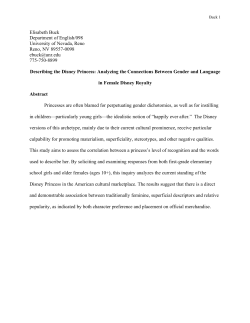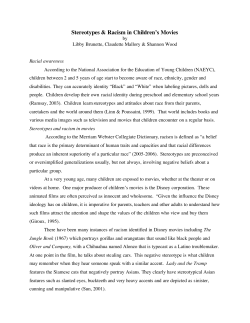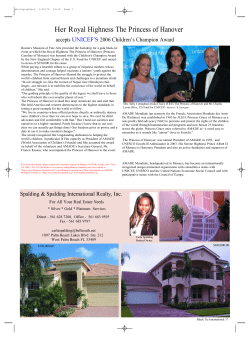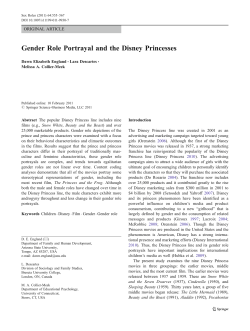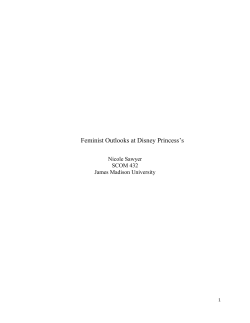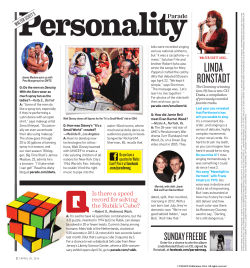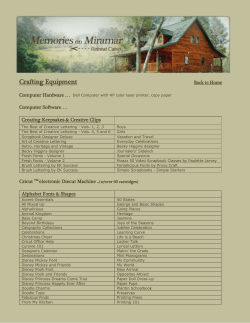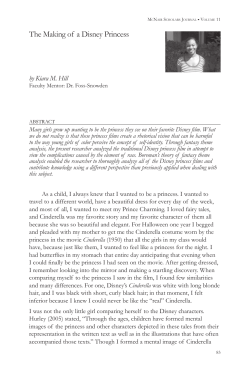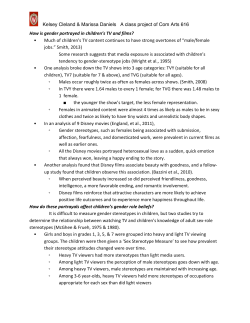
Beyond the Prince: Race and Gender Role Portrayal in Disney...
Beyond the Prince: Race and Gender Role Portrayal in Disney Princess Films Brianna May Undergraduate Saint Mary’s College, Notre Dame, IN bsmith01@saintmarys.edu December 15, 2011 Faculty Advisor: Dr. Mary Ann Kanieski Email Address: kanieski@saintmarys.edu Abstract The Disney Corporation made their first princess film in 1937 and has continued producing these movies. Over the years, Disney has received criticism for their gender interpretations and lack of racial diversity. This study will examine princess films from the 1990’s and 2000’s and decide whether race or time has an effect on the gender role portrayal of each character. By using a content analysis, this study identified the changes with each princess. The findings do suggest the princess characters exhibited more egalitarian behaviors over time. 1 The Disney Princess franchise began in 1937 with Snow White and the Seven Dwarfs and continues with the most recent film was Tangled (Rapunzel) in 2011. In past years, Disney film makers were criticized by the public audience for lack of ethnic diversity. In 1995, Disney introduced Pocahontas and three years later Mulan emerged creating racial diversity to the collection. Eleven years later, Disney released The Princess and the Frog (2009). The ongoing question is whether diverse princesses maintain the same qualities as their European counterparts. Walt Disney’s legacy lives on, but viewers are still curious about the all white princess collection which did not gain racial counterparts until 58 years later. It is important to recognize the role the Disney Corporation plays in today’s society. The company has several princesses’ films with matching merchandise. Parents purchase the items for their children and through film and merchandise, children are receiving messages such as how a woman ought to act, think or dress. Gender construction in Disney princess films remains important because of the messages it sends to children. We need to know whether gender roles presented in the films downplay the intellect of a woman in a modern society or whether Disney princesses are constricted to the female gender roles such as submissiveness and nurturing. In addition, we need to consider whether the messages are different for diverse princesses. The purpose of the study is to investigate the changes in gender construction in Disney princess characters related to the race of the character. This research also examines how gender construction of Disney princess characters changed from the 1900’s to 2000’s. A comparative content analysis will analyze gender role differences between women of color and white princesses. In particular, the study will ask whether race does matter in the gender roles revealed among each female character. By using social construction perspectives, Disney princesses of color were more masculine, but the most recent films became more egalitarian. 2 LITERATURE REVIEW Women in Disney film Davis (2006) examined women in Disney animated films by creating three categories: The Classic Years, The Middle Era, and The Eisner Era. The Classic Years, 19371967 were described as the beginning of Disney. During this period, women were rarely featured alone in films, but held central roles in the mid-1930s (Davis 2006:84). Three princess films were released and the characters carried out traditional feminine roles such as domestic work and passivity. Davis (2006) argued the princesses during The Classic Era were the least active and dynamic. The Middle Era, 1967-1988, led to a downward spiral for the company after the deaths of Walt and Roy Disney. The company faced increased amounts of debt and only eight Disney films were produced. The representation of women remained largely static (Davis 2006:137). The Eisner Era, 1989-2005, represented a revitalization of Disney with the release of 12 films with leading female roles. Based on the eras, Davis argued there was a shift after Walt Disney’s death which allowed more women in leading roles and released them from traditional gender roles. Independence was a new theme in this era allowing women to be self- sufficient unlike women in The Classic Era who relied on male heroines. Gender Role Portrayal in films England, Descartes, and Meek (2011) examined the Disney princess films and challenged the ideal of traditional gender roles among the prince and princess characters. The study consisted of all nine princess films divided into three categories based on their debut: early, middle and most current. The researchers tested three hypotheses: 1) gender roles among males and female characters would differ, 2) males would rescue or attempt to rescue the princess, and 3) characters would display more egalitarian behaviors over time (England, et al. 2011:557-58). The researchers coded traits as masculine and feminine. They concluded that princesses 3 displayed a mixture of masculine and feminine characteristics. These behaviors implied women are androgynous beings. For example, princesses portrayed bravery almost twice as much as princes (England, et al. 2011). The findings also showed males rescued women more and that women were rarely shown as rescuers. Overall, the data indicated Disney princess films had changed over time as women exhibited more masculine behaviors in more recent films. Choueiti, Granados, Pieper, and Smith (2010) conducted a content analysis regarding gender roles in top grossing G- rated films. The researchers considered the following questions: 1) What is the male to female ratio? 2) Is gender related to the presentation of the character demographics such as role, type, or age? and 3) Is gender related to the presentation of character’s likeability, and the equal distribution of male and females from 1990-2005(Choueiti et al. 2010:776-77). The researchers concluded that there were more male characters suggesting the films were patriarchal. However, there was no correlation with demographics of the character and males being viewed as more likeable. Lastly, female representation has slightly decreased from 214 characters or 30.1% in 1990-94 to 281 characters or 29.4% in 2000-2004 (Choueiti et al. 2010:783). From examining gender role portrayals, females have become androgynous while maintaining minimal roles in animated film. Television and Film Davis (1990) evaluated women in prime-time television. He argued that The Mary Tyler Moore Show was the first to portray a female character as independent (Davis 1990:327). Through his observations from previous studies, he examined how women are portrayed in night time television. Davis recorded networks’ weekly lineup programs. He found that 65.4% of the characters were males (Davis 1990:329). Women were slightly younger favored auburn or 4 blonde hair and dressed provocatively. Davis concluded women were exposed as sexualized beings. Bufkin, Eschholz, and Long (2002) studied the demographic composition of modern films from 1996. The study evaluated: 1) the prevalence of women and minorities in leading roles in film, 2) the diversity of their employment experiences, 3) marital and parental statuses and 4) age and gender qualifications (Bufkin et al. 2002:309). The researchers concluded women were underrepresented in films (35%), even though they made up 51% of the population during 1996 (Bufkin et al. 2002). In comparison, individuals of color represented 30 leading characters. Bufkin found more males were employed than females, but more women were married indicating marriage was necessary to carry out the traditional feminine behavior as a homemaker. Finally, the findings showed women were younger and still remain in pink collar jobs. The research also demonstrated racial minorities were portrayed with less control then white males who obtain power. Race Graves (1999) studied the lack of racial and ethnic diversity in television. Graves (1999) found that when people of color were included on television, stereotypes were visible. Inclusion and exclusion of minorities together help the dominant culture to develop positive or negative attitudes about racial groups. Graves describes exclusion of racial characters as promoting images of powerlessness and less important. However, she argued that inclusion of racial groups on television provides positive social and cultural characteristics of the group. In addition to the limited television time given to people of color, they portrayed characters as supporting and 5 background roles. People of color were often shown with positive or negative attitudes (Graves 1999:710). Graves found the television has not allowed equal opportunities for all people. Hurley (2005) argued that there is a relationship between self-image and portrayal of race and ethnicity in Disney films. Disney failed to have a racial representative leaving some children without a character to relate to. In relation to self-image, Hurley discussed the color symbolism of black and white. From Snow White and the Seven Dwarves, Snow White was depicted as pure because her skin was described as ‘white as snow’ (Hurley 2005:223), unlike Ursula, the villainous octopus from The Little Mermaid, who was dressed in all black and with black blood in her breasts. The films created a symbolism associating white with goodness and black with evil (Hurley 2005:224). Hurley examined other color symbols in Disney films and concluded colors have an impact on racial minorities even without a representative in films. Gregory (2010) argued The Princess and the Frog stressed two important themes: Tiana’s desire to own her own restaurant and the maintenance of whiteness. Gregory first pointed out Disney maintained whiteness by allowing Tiana’s best friend, Charlotte, a white upper class woman to hold the princess title while Tiana remained in amphibian form. The other theme was the interracial relationship of Prince Naveen and Tiana. Naveen is not African American but from the imaginary land of Maldonia. This shows maintaining whiteness with Tiana marrying outside of her race encouraging more modern values. Parasecoli (2010) claimed The Princess and the Frog showed off Tiana’s culinary skills and made her more acceptable for mainstream audiences (Parasecoli 2010:451). The researcher examined elements associated with the black princess such as gumbo and food. Gumbo was described as bringing individuals together because of the different ingredients represented the 6 different racial groups. Race and food connected because race was perceived as a flavor carrying an exotic feeling. Race and ethnicity then becomes spices giving flavor to the blandness of mainstream culture through dynamics of appropriation and commodification while do little to modify privileges and hegemonic power (Parasecoli 2010:455). Race becomes an exotic commodity which excited individuals from the dominant culture. Parasecoli’s view suggested this makes Tiana acceptable to white audiences because of the racial authenticity. Tiana’s journey cook to restaurant owner created less pressure from her race and more focus on her capabilities. The literature gathered for this study examines the changes in gender construction of Disney princess characters from the 1990’s to 2000’s while examining the race of the character. Previous studies have pointed out the lack of racially diverse characters, but did not examine if women of color characters display different characteristics than their white counterparts. Lastly, most of the studies suggested over time. Disney films had changed, but more detailed research was necessary. The previous literature has found Disney has increased the number of women as leading characters. Others have examined gender role portrayal among characters. Finally, some research found that Disney had harmful effects on others by not allowing a variation of racial representatives in films. This research will examine the impacts on race and gender construction for the most recent films. THEORY Sociologists believe that individuals learn their roles through a process of socialization, such as watching their parents or characters in social media. In other words, individuals learn roles through outside experiences that show how an individual does a particular task. Scholars who describe the “reality” of these socialized roles may use a social construction perspective. 7 The social construction perspective helps us understand how these roles are created. Two such theorists, Peter L. Berger and Thomas Luckmann in The Social Construction of Reality (1966), examined how the social world is constructed. This theory lays a foundation for understanding specific social constructions including gender and race representations in the media. In The Social Construction of Reality (1966), Berger and Luckmann described how the world was viewed by social theorists as an objective reality. The objective reality is characterized as the predetermined path that individuals follow. From this perspective the individual is limited in their capabilities to act because the objective reality predetermines the actions already established. The objective reality is a fixed state in which members are not able to construct an identity other than what has already been shaped according to what is believed to be nature. In contrast to an objective reality, Berger and Luckmann argue for a subjective reality in which human action is learned over time. The individual learns about society through observation. This knowledge of how to act occurs through two processes of socialization: primary and secondary socialization. Primary socialization is the first socialization a child undergoes during childhood and identifies the individual as a member of society (1966:130). According to Berger and Luckmann, (1966:136) learning how to write one’s name becomes part of primary socialization. During this socialization process, differences among individuals are noticed, such as what one child of a certain age is capable of as compared to another child. The capabilities of one child in comparison to another become an indicator of how a child internalizes the world. A child becomes aware the advantages one child has over another because of their socialization experience. Secondary socialization involves developing a complex 8 awareness of subcultures, such as language differences. Individuals learn through this process of socialization how other cultures operate. Gender roles also provide an illustration of the socialization process. Lorber (1994) focuses on how a gender role is carried out. She argues gender performance is what individuals do on a day-to-day basis because they are socialized to behave in this manner. For Lorber, gender is at the center of all debates. For example, individuals work in gendered ways based on how they are socialized; men are taught to take breadwinning roles earning more money while women are socialized to take pink collar careers such as nurses and teachers. Lorber’s central argument is gender has become a social institution. The institution of gender is formed from individual socialization. She points out that gender is a central way human beings organize their life (Lorber 1994:15). The institution of gender is a binary model that has little room for categories other than male and female. Lorber (1994) contends: Western societies have only two genders, “man” and “woman.” Some societies have three genders-men, women, and berdaches or hijras or xaniths. Berdaches, hijras, and xaniths are biological males who behave, dress, work, and are treated in most respects as social women; they are therefore not men, nor are they female women; they are, in our language, “male women” (17). The binary construction of gender exemplifies Berger and Luckmann’s concept of objective reality. Binary gender categories were thought to be fixed similarly to the objective reality of nature. However, Lorber’s identification of a third sex suggests that social construction theory can be used to study gender. Omi and Winant conduct a similar analysis of race. In Racial Formations in the United States (1994), Michael Omi and Howard Winant explore the meaning of race. Race is a concept which signifies and symbolizes social conflicts and interest by referring to different types of human bodies (Omi and Winant 1994:55). 9 Individuals view race as a cultural marker; something that is visibly noticeable. When individuals have this marker, but does not match the dominant culture’s expectation it creates confusion. The confusion occurs because individuals like to see the world from a racial formation perspective. Racial formation is a sociohistorical process, in which racial categories are created, inhabited, transformed, and destroyed (Omi and Winant 1994:55). Omi and Winant described two ways in which racial formation works through social structure and cultural representation. The social structure depicts the way in which the larger society views race. For instance, racism justifies racial oppression between blacks and whites. Past experiences play a role in how the whole society faces the issue. The social structure view of racial formation is socially constructed because the meaning changes in time and place. Omi and Winant argue that a cultural representation of racial formation is viewed by people as fixed and immutable (1986:17). Cultural representation operates on a micro level because it focuses on a smaller scale. Omi and Winant argue cultural representation shapes our view of culture. For example, the way one talks, acts, reads or dresses is shaped by race. Omi and Winant’s Racial Formation theory correlates with the social construction theory. The social structure view is observed through history and individuals interpret it as a reason race is seen. This view is consistent with Berger and Luckmann’s understanding of the objective reality because it is viewed as fixed. By contrast, the cultural representation view argues for a subjective reality because race is predetermined by birth. Skin color is a cultural marker that identifies the individual by their race at birth it cannot be changed. 10 In connection with Disney princess films, the gender roles are linked in the racial identity of the character. The social construction perspective allows the individual to understand how the social world is constructed. Racial formation opens one’s understanding of how race is viewed through two ways. The theories connect with the characters’ roles and will be examined through the films. METHODOLOGY This study is a content analysis looking at the gender construction of Disney Princess characters by race. In addition, changes from the 1900’s to 2000’s will be examined. A content analysis “is a technique for examining information, or content, in written or symbolic material” (Neuman 2007:20). This methodology was selected in order to assess traditional masculine and feminine behaviors among princesses. Similar methodology has been shown to be useful and valid in previous research (Thompson and Zerbinos 1995). England et al. (2011) suggested this method allows researcher to collect quantitative information about the types of behavior portrayed by the princesses. Sample The sample consisted of six Disney princess films: The Little Mermaid (1989), Beauty and the Beast (1991), Pocahontas (1995), Mulan (1998), The Princess and the Frog (2009), and Tangled (2010). Of the six princesses, three were racially diverse: Pocahontas, Mulan, and Princess and the Frog (Tiana). These films were chosen because they focused on the story of a princess and debuted in the 1990-2000 time period. Davis (2006) explained during the Eisner Era, 1989-2005, Disney produced 12 films with leading female characters. Four of the six in the Eisner Era were used for this study. 11 Coding The behaviors used to evaluate the princesses were taken from previous studies. A copy of the coding sheet is attached Appendix A. The researcher adapted the coding sheet using England et al. (2011). Based on England, the following behaviors were coded as traditionally masculine: physically strong and athletic. In contrast, traditional feminine roles included affectionate and collapses to cry. The complete list of masculine and feminine traits is available in Appendix B in detail. The researcher altered the coding after viewing the first few films because important behaviors were left out. For example, the code, collapsing to cry indicated the princess must exhibit a specific behavior such as hiding her face to be coded. In other instances of crying, the behavior was ignored and the researcher decided to code this behavior. Domestic work, being apologetic and curious about the prince were added because they were presented in the films. Coding Procedure The researcher carefully watched all six princess films twice. Each film was approximately 90 minutes. The coding sheet provided a space for the year and the name of the film. The data included the behavior, time of the behavior, and a brief description of the scene. The study focused on the princess when present on the screen. While watching the films, the number of minutes the princess on screen was recorded. In order to keep track of the behavior, the timer remained on the viewing screen. When an action appeared, the film was paused and coded. Each film was played back and fast forwarded when the princess was absent. Frequent breaks were strongly encouraged to prevent missing important data. The coding procedure was based on (England et al. 2011): 12 The character was assigned one code every time (a) were mentioned as possessing a certain behavior or (b) exhibited the characteristic in their behavior. Each time the character exhibited a new behavior, the behavior was coded. In addition, a new behavior was coded for each time the scene changed (i.e., the animated picture changed or shifted to a new setting), even if that was exhibited in previous scenes. The researcher coded simultaneous behaviors when two codes worked together as one behavior. FINDINGS The following data is organized based on the two variables in the research question: race and time. Tables were categorized by the general topic, gender roles to specific, individual traits. Table 1 presents the combined total of masculine and feminine traits for the two groups of characters. Table 2 provides percentage of masculine and feminine behaviors for each film while Table 3 provides the entire list of the two gender role characteristics. It will be used to explain the most important findings and for the second variable, time. These findings were analyzed in order to decide whether race or time has an effect on the gender role construction of each princess character. Table 1 Total Masculine and Feminine Behaviors Masculine Behaviors Feminine Behaviors Total behaviors White Princesses 129 (34%) 251 (66%) 380 Princesses of color 169 (37%) 290 (63%) 459 Total of all behaviors 298 (36%) 541(64%) 839 Table 1 showed the overall differences in behaviors among the two groups of princesses. All together, the princesses held more traditional feminine roles (64%) and expressed fewer masculine roles (36%). The white princesses were slightly more feminine (66%) compared to 13 the princesses of color (63%). Princesses of color possessed the most masculine behaviors (37%) while the other group trailed behind with (34%). Table 2 Total Masculine and Feminine Behaviors for each princess The Little Beauty Mermaid* and the Beast* Masculine 21 34 (21%) (29%) Feminine 78 83 (79%) (71%) Total beh 99 117 *indicates white princes Tangled* Pocahontas** Mulan** 74 (45%) 90 (55%) 164 52 (45%) 64 (55%) 116 55 (34%) 109 (66%) 164 Princess and the Frog** 62 (35%) 117 (65%) 179 Total of all behaviors 298 541 839 **indicates princess of color Table 2 presented totals for all the behaviors for each film. Of the white princesses, Ariel appeared the most feminine (79%) followed by Belle (71%). For the princesses of color, Mulan had more feminine characteristics (66%) than Tiana (65%). Surprisingly, Rapunzel and Pocahontas shared (55%) for feminine behaviors suggesting a more egalitarian gender role construction. The pattern for masculine traits was reversed for the princesses. The next table focused on all the given behaviors, but specific traits were discussed. 14 Table 3 Feminine and Masculine Behaviors in Princesses (* white princess ** princess of color) List of Traits The Little Mermaid* (1989) Tangled* (2010) (Ariel) Beauty and the Beast* (1991) (Belle) Pocahontas** Mulan** (1995) (1998) Princess and the Frog** (2009) (Tiana) (Rapunzel) Masculine Trait Explore Strong Assertive Unemotional Independent Athletic Intellectual Inspires fear Brave Gives advice Leader Praised Feminine Traits Tends to appear Weak Submissive Shows emotion Affectionate Nurturing Sensitive Tentative Helpful Troublesome Fearful Ashamed Collapse crying Attractive Asks advice Victim Apologetic Curious prince Crying Domestic 3 (3%) 3 (3%) 3 (3%) 1 (1%) 0 5 (5.1%) 2 (2%) 1 (1%) 1 (1%) 2 (2%) 0 0 4 (3.4%) 2 (1.7%) 7 (6%) 5 (4.2%) 1 (1%) 3 (2.6%) 3 (2.6%) 1 (1%) 5 (4.3%) 2 (1.7%) 1 (1%) 0 2 (1.2%) 26(15.8%) 12 (7.3%) 7 (4.2%) 0 20(12.1%) 3 (1.8%) 1 (.6%) 1 (.6%) 1 (.6%) 1 (.6%) 0 1 (.8%) 4 (3.4%) 6 (5.1%) 2 (1.7%) 1(.8%) 27 (23.2%) 4 (3.4%) 1 (.8%) 0 4 (3.4%) 1 (.8%) 1 (.8%) 2 (1.2%) 13(7.9%) 3 (1.8%) 2 (1.2%) 1 (.6%) 19(11.5%) 2 (1.2%) 1 (.6%) 6 (3.6%) 2 (1.2%) 2 (1.2%) 2 (1.2%) 0 12(6.7%) 9 (5%) 4 (2.2%) 6 (3.3%) 17 (9.4%) 3 (1.6%) 1 (.5%) 4 (2.2%) 6 (3.3%) 0 0 7 (7.1%) 1 (1%) 2 (2%) 25 (25%) 7 (7.1%) 1 (1%) 0 1 (1%) 0 1 (1%) 11(11%) 2 (2%) 3 (3%) 6 (6.1%) 2 (2%) 1 (1%) 0 8 (8.1%) 0 0 0 4 (3.4%) 3 (2.6%) 27(23.1%) 15(12.8%) 4 (3.4%) 1 (1%) 0 6 (5.1%) 1 (1%) 10(8.5%) 0 4 (3.4%) 0 1 (1%) 2 (1.7%) 1 (1%) 2 (1.7%) 2 (1.7%) 0 2 (1.2%) 6 (1.2%) 1 (.6%) 24(14.6%) 10(6%) 5 (3%) 0 5 (3%) 0 0 16(9.7%) 0 2 (1.2%) 3 (1.8%) 1 (.6%) 4 (2.4%) 2 (1.2%) 5 (3%) 3 (1.8%) 1 (.6%) 2 (1.7%) 1 (.8%) 1 (.8%) 16 (13.7%) 13 (11.2%) 5 (4.3%) 0 0 1 (.8%) 2 (1.7%) 5 (4.3%) 1 (.8%) 1 (.8%) 0 4 (3.4%) 1 (.8%) 0 11 (9.4%) 0 0 2 (1.2%) 7 (4.2%) 2 (1.2%) 44(26.8%) 2 (1.2%) 2 (1.2%) 3(1.8%) 1 (.6%) 2 (1.2%) 1 (.6%) 21(12.8%) 5 (3%) 1 (.6%) 2 (1.2%) 1 (.6%) 5 (3%) 5 (3%) 3 (1.8%) 0 0 2 (1.1%) 7 (3.9%) 3 (1.6%) 29(16.2%) 33(18.4%) 1 (.5%) 5 (2.7%) 0 2 (1.1%) 3 (1.6%) 10 (5.5%) 1 (.5%) 0 5 (2.7%) 7 (3.9%) 4 (2.2%) 1 (.5%) 4 (2.2%) 0 0 Total behaviors 99 117 164 116 164 179 15 Table 3 is being used for race and time periods of the characters. For this section, specific feminine traits were observed for each film. Four feminine characteristic: shows emotion, affectionate, fearful, and tend to physical appearance were highlighted because they had interesting findings. Mulan was the most emotional (26.8%) of the princesses and minority characters compared to the lowest, Pocahontas (13.7%). On the other hand, Ariel expressed a fair amount of emotional traits (25%) among the white princesses and Rapunzel with the least emotional (14.6%). Emotions tended to appear more in the racially diverse characters as well as affectionate behavior. Tiana had (18.4%) affectionate behaviors while Belle had (12.8%). Pocahontas had less than Belle with (11.2%). Following Pocahontas, Ariel (7.1%) and Rapunzel (6%) combined were below the highest affectionate trait, but Mulan had the smallest amount with (1.2%). Despite Mulan having the smallest amount of affection, she held more than enough fear. Mulan displayed the most fearful characteristics (12.8%), almost twice the amount of Tiana (5.5%). Ariel came after Mulan with (11%) fearful behaviors while Rapunzel (9.7%) and Belle (8.5%) illustrated smaller instances of fear. Pocahontas had the fewest fearful traits (4.3%). The emphasis on physical appearance was also studied. Ariel tended to her physical appearance (7.1%). She was most likely to comb her hair and look at herself in the mirror while the remaining princesses showed less than (2%) for this trait. The next portion of the findings focuses on masculine traits in the female characters. The masculine traits athleticism and physically strong will be examined in the next section. 16 Belle was the least athletic (2.6%), but Rapunzel strongly favored athleticism (12.1%) among the white princesses. Pocahontas surpassed them (23.2%) and other princesses were behind her Mulan (11.5%) and Tiana (9.4%). Rapunzel had the greatest total of physical strength (15.8%), two times greater than Mulan (7.9%) and Tiana (6.7%). Pocahontas (3.4%), Ariel (3%), and Belle (1.7%) illustrated fewer masculine characteristics. Table 4 Total Masculine and Feminine Behaviors for Time Periods Early Middle Most Recent Total of all (Mulan and (Tiana and behaviors (Ariel and Belle) Pocahontas) Rapunzel) Masculine 55 (25%) 107 (38%) 136 (40%) 298 Feminine 161 (75%) 173 (62%) 207 (60%) 541 Total 216 280 343 839 Table 4 presented changes in gender role behaviors for the three time periods. The earliest films had (75%) feminine traits compared to (60%) in the most recent princesses. Surprisingly, the most recent films were (40%) masculine in contrast to (38%) in the middle time period. Masculine and feminine selected traits were examined for time periods following the same format as racial groups using Table 3. Being fearful and showing emotions were the feminine selected behaviors when observing time. In both instances, Mulan was (12.5) fearful and (26.8%) emotional, expressing the most feminine qualities. By contrast, Pocahontas, also in Mulan’s time period had the least selected characteristics (4.3%) and (13.7). After Mulan, the earlier character, Ariel constructed her femininity with (11%) fear and (25%) showing emotion. The most recent princesses, Tiana was (5.5%) fearful and (16.2%) emotional. Masculine behavior differed for the princesses. The most recent princesses shared a combined total of (40%) masculine traits (see Table 4), however individually the princesses created a range of behaviors. From the earliest character, 17 Ariel to the most recent character, Rapunzel there has been a 15% increase in masculine behaviors. The princesses exhibited more masculine behaviors and traits such as athletic, assertive, and physically strong were looked at. The middle period princesses, Mulan (23.2%) and Pocahontas (12.1%) had more athletic behaviors than Belle (2.6%) and Rapunzel (4.4%). Pocahontas had (7.2%) assertiveness and Belle (6%) compared to (2.6%) athleticism making her have the second highest assertive ability. Mulan (5.1%) and Rapunzel (5%) were fairly close and behind were Ariel (3%) and Tiana (1.8%). Lastly, Pocahontas (15.8%) possessed more strength and Belle (1.7%). The findings show the middle and most recent eras resemble gender role behaviors. This data shows that race does not appear to have a large effect on the masculine and feminine characteristics of the princesses. The princesses of color expressed slightly more masculine behaviors than white princesses. When the films were divided into time categories, there was a significant difference. The earliest films performed more traditionally feminine gender roles and over time the newer film took on more traditionally masculine gender roles. These findings suggested that from the earliest film in the sample, The Little Mermaid to the most recent, Tangled that the princesses maintained both masculine and feminine characteristics over the 21 year time span. DISCUSSION Berger and Luckmann (1966) theorize the social construction of reality in understanding how the world is constructed through an objective and subjective reality. This theory applies to this study because of princess character’s construction. The objective reality argues for a predetermined path to follow or a model of how things ought to be. Similarly, the Disney 18 Corporation follows this pattern in their films. For example, the gender role behavior, curiosity about the prince, most likely began with the first Disney princess films. It is inferred that Disney applies behaviors to other princess films such as The Little Mermaid. Ariel is interested in attracting the prince’s attention because of the model path filmmakers used from previous princesses. The model path creates patterns because of the habitual behaviors. This behavior has an impact on young girls teaching them how to draw attention to one’s self to attract a male. By contrast, the subjective reality sees human interaction over time changing the princess characters’ behaviors. The princess films relate to the subjective reality because over time the princesses change. When human interaction is altered, Disney responded by revamping the gender role traits of the princesses. One of the earliest films, Beauty and the Beast (1991) portrays Belle as affectionate after accepting the role as the Beast’s prisoner. Belle isolates herself from objects in the castle, but eventually becomes attached to the Beast through hugs and kisses. Belle’s behavior is seen as passive assuming women of the early nineties were this way. However, as women take on more active roles, Disney creates more active characters. For instance, in Mulan (1998) is a warrior fighting for her country. She is not concerned with beauty like Ariel, but communicates fear through her facial expressions and shows her physical strength in basic training. The princesses are seven years apart, but women are active and Disney recognizes the change. The social construction of gender perspective pertains to this study because Lorber views gender as a way humans organize their life (Lorber 1995:15). This gender role interpretation is noticeable in Disney princess films. The films used for this study were directed by all men; it is possible that the male directors construct the female characters with traditional feminine gender roles. The data shows that among all of the characteristics, females portray 541 (64.5%) 19 feminine behaviors compared to 298 (35.5%) masculine characteristics. Lorber’s theory supports the change in gender constructions over time as seen in Rapunzel. Rapunzel is the most recent Disney princess and is headed towards androgyny. She portrays (45%) masculine and (55%) feminine characteristics. Although, the character wears a purple dress, she exhibits her masculine traits in her physical strength and athleticism. She does not appear to rely on a male, but takes control. Lorber would agree Disney’s characters have changed the gender construction since the first princess film in 1937. Social construction perspectives have more meaning than racial formation in this study. There was little evidence of Racial Formation related to gender construction with the exception of The Princess and the Frog and Pocahontas. While Parasecoli (2011) argues that filmmakers focus on Tiana’s culinary skills to make her more acceptable to the dominant culture, she is more feminine. Similarly, Racial Formation in Pocahontas is likely due to the interpretation of the film. Her story, a non-fiction historical folktale, makes her more realistic. For the other princesses, racial formation is absent because their stories overshadow their race. Mulan is Chinese, but her struggles to fight for China become the bigger picture than her race. In the same sense, the white princesses do not focus on race, because they are already acceptable to the dominant culture. In the case of Tiana and Pocahontas, directors have to work twice as hard to create narratives for everyone to enjoy. Strengths and Weaknesses This study was successful because the films were accessible. Unlike a qualitative project requiring an IRB, informed consents and participants, the materials were within proximity. The researcher purchased the films at local discount stores and borrowed others from acquaintances. 20 The coding system found in the study from England et al. (2011) was another strength. It was convenient and easy to follow. The researcher had the advantage of looking for behaviors to code right away. England et al.’s (2011) codes were a broad range of both traditionally masculine and feminine traits. The final strength was the project was completed in the time necessary. Time provided for this study allowed the researcher to schedule when to write and code the films. However, if the study required other participants’ critiques and coding films, the project would be difficult to complete in the time give. Weaknesses in the study created obstacles and ideas for future projects. Because this content analysis was a solo project, there was no intercoder reliability. As stated in the methodology, the researcher had to watch the films carefully and twice. When the data was ready to be analyzed, several behaviors were eliminated if they did not match within three seconds. This hurt the data because behaviors which were important were eliminated due to the rule. England et al.’s (2011) studied featured more than one researcher giving them more reliability. Another weakness was the study remained subjective because the films were watched and critiqued by one person. If the researcher had interviewed individuals about their beliefs on race and gender construction in the six princesses, it would have been a better combination. It was more important to focus on a specific lens of the princesses than go in every possible direction. This weakness could be used as a potential future project. Future researchers could watch films and ask participants about gender role construction using the same sample for this study. 21 One of the overall weakness was the storyline for the film, Tangled. Even though it was the most recent film, the way the character uses her hair skewed the data. For instance, Rapunzel pulls her mother up to the tower with her hair and the behavior was coded as physically strong. Throughout the film, the behavior is repeated causing the princess an abundance of masculine characteristics. Similarly, this happens with athleticism and Rapunzel overall surpasses her counterparts in skills two to five times more. Over England et al’s study (2011) allowed the researcher to explore gender role portrayal, but refine it with other aspects. The social construction approach supports the overall data suggesting the princesses’ construction has changed over the 21 year time span. Perhaps, in years to come, the future princesses will have an equal representation of masculine and feminine characteristics. Omi and Winant’s theory applies to some of the princesses suggesting that racial formation does not have a strong impact on gender role construction. If Disney creates another princess of color, one can hope she will be just a princess such as Ariel or Belle instead of drawing a plot for social acceptance. REFERENCES Beauty and the Beast. Director Gary Trousdale and Kirk Wise. The Walt Disney Company. 1991. Berger, Peter L. and Luckmann, Thomas. 1966. The Social Construction of Reality: A Treatise in the Sociology of Knowledge. Garden City, New York, USA: Doubleday & Company, Inc. Bufkin, Jana, Eschholz, Sarah, and Long, Jenny. 2002. “Symbolic Reality Bites: Women and Racial/Ethnic Minorities in Modern Film.” Sociological Spectrum 22 (3) 299-34. Choueiti, Marc, Granados, Amy, Pieper, Katherine M., and Smith, Stacy L. 2010. “Assessing Gender Related Portrayals in Top-Grossing G-Rated Films.” Sex Roles 62 (11/12) 772-86. Davis, Amy M. 2006. Good Girls and Wicked Witches: Women in Disney’s Feature Animation Eastleigh, United Kingdom: John Liberty Publishing. Davis, Donald. 1990. “Portrayal of Women in Prime-Time Network Television: Some Demographics Characteristics.” Sex Roles 23(5-6):325-33. England, Dawn Elizabeth, Descartes, Lara, and Collier-Meek, Melissa A. 2011 “Gender Role Portrayal and the Disney Princesses.” Sex Roles 64 (7-8):555-67. Graves, S.B. 1999. “Television and Prejudice Reduction: When does television vicarious experience make a difference?” Journal of Social Issues. 55:707-25. Gregory, Sarita McCoy. 2010. “Disney’s Second Line: New Orleans, Racial Masquerade, and the Reproduction of Whiteness in The Princess and the Frog.” Journal of African American Studies 14(4): 432-49. Hurley, Dorothy L. 2005. “Seeing White: Children of Color and the Disney Princess Fairy Tale Princess.” The Journal of Negro Education 74(3):221-32. Lorber, Judith. 1994. Paradoxes of Gender. New Haven: Yale University Press. Mulan. Director Tony Bancroft and Barry Cook. The Walt Disney Company. 1998. Neuman, W. Lawrence. 2007. Basics of Social Research: Qualitative and Quantitative Approaches. Boston, MA: Pearson Education. Omi, Michael and Winant, Howard.1986. “Racial Formation.” Pp. 13-22 in Race, Class, and Gender in the United States: An Integrated Study, edited by Paula S. Rothenberg and William Patterson. New York: St. Martin’s Press. Omi, Michael and Winant, Howard. 1994. Racial Formation in the United States: From the 1960s to 1990s. New York, New York: Psychology Press. Parasecoli, Fabio. 2010. “A Taste of Louisiana: Mainstreaming Blackness Through Food in The Princess and the Frog.” Journal of African American Studies 14 (4):450-68. Pocahontas. Director Mike Gabriel and Eric Goldberg. The Walt Disney Company. 1995. Tangled. Director Byron Howard and Nathan Greno. The Walt Disney Company. 2010. The Little Mermaid. Director Ron Clements and John Musker. The Walt Disney Company. 1989. The Princess and the Frog. Director Ron Clements and John Musker. The Walt Disney Company. 2009. Thompson, Teresa L. and Zerbinos, Eugenia. 1995. “Gender Roles in Animated Cartoons: Has the Picture Changed in 20 Years?” Sex Roles 32(9/10):651-73. APPENDIX A CODING SHEET Title of the Film____________________________________ Year of the Film _______ Behavior Time Description of Behavior ______________________________________________________________________________ ______________________________________________________________________________ ______________________________________________________________________________ ______________________________________________________________________________ ______________________________________________________________________________ ______________________________________________________________________________ ______________________________________________________________________________ ______________________________________________________________________________ ______________________________________________________________________________ ______________________________________________________________________________ ______________________________________________________________________________ ______________________________________________________________________________ ______________________________________________________________________________ ______________________________________________________________________________ ______________________________________________________________________________ ______________________________________________________________________________ ______________________________________________________________________________ ______________________________________________________________________________ ______________________________________________________________________________ ______________________________________________________________________________ ______________________________________________________________________________ ______________________________________________________________________________ ______________________________________________________________________________ ______________________________________________________________________________ ______________________________________________________________________________ ______________________________________________________________________________ ______________________________________________________________________________ ______________________________________________________________________________ ______________________________________________________________________________ ______________________________________________________________________________ ______________________________________________________________________________ ______________________________________________________________________________ ______________________________________________________________________________ ______________________________________________________________________________ ______________________________________________________________________________ ______________________________________________________________________________ ______________________________________________________________________________ ______________________________________________________________________________ ______________________________________________________________________________ ______________________________________________________________________________ ______________________________________________________________________________ ______________________________________________________________________________ ______________________________________________________________________________ ______________________________________________________________________________ ______________________________________________________________________________ ______________________________________________________________________________ ______________________________________________________________________________ ______________________________________________________________________________ ______________________________________________________________________________ ______________________________________________________________________________ ______________________________________________________________________________ ______________________________________________________________________________ ______________________________________________________________________________ ______________________________________________________________________________ ______________________________________________________________________________ ______________________________________________________________________________ ______________________________________________________________________________ ______________________________________________________________________________ ______________________________________________________________________________ ______________________________________________________________________________ ______________________________________________________________________________ ______________________________________________________________________________ ______________________________________________________________________________ ______________________________________________________________________________ ______________________________________________________________________________ ______________________________________________________________________________ ______________________________________________________________________________ ______________________________________________________________________________ ______________________________________________________________________________ APPENDIX B Masculine Characteristics M1: Wants to explore: to search for, to investigate, to want to find or explore the unknown. M2: Physically strong: hitting or moving something, providing evidence that the character had a strong physical effect on the person or object. This was different from simple athletic display. There was a separate code for athletic, defined below, and the codes were mutually exclusive, as it was understood that displays of physical strength often incorporated some athleticism. M3: Assertive: insistence upon a right or claim, the action of declaring or positively stating. Assertiveness included polite assertiveness with a hint of aggression. Assertiveness was a strong, direct assertion of a position or idea. M4: Unemotional: repression of emotion, indifference to pleasure or pain. A character was unemotional in response to something that might seem to warrant an emotional response, such as death. M5: Independent: not depending on the authority of another, autonomous, self-governing. A character was considered independent when performing an independent action against many, being alone when it was not the norm, or participating in the expected culture. M6: Athletic: a specific jump or kick that was large enough to require some athleticism. Running was also coded as athletic. M7: Engaging in intellectual activity: engaging in the intellect, including reading or showing the use of thought. M8: Inspires fear: causing someone to respond with fear, which is defined as uneasiness caused by the sense of impending danger. This includes portraying violence and aggression, intimidation, or unintentionally inspiring fear as well. M9: Brave: courageous, daring, intrepid. Bravery often involved a rescue or leadership in the face of danger. M10: Gives advice: providing suggestions, recommendations or consultation. This was coded regardless of whether advice was asked for or whether it was warranted appreciated, or helpful. M11: Leader: one who leads, a commander. Leader was only coded if the character was leading a group of people, not animals and not just him- or herself. It also was only used to describe physical leadership in which a person is seen in front of and directing people and involving giving orders. M12: Praised: The individual was praised with a pat on the back or rewarded with words such as good job. Feminine Characteristics F1: Tends to physical appearance: adjusting physical appearance for the purpose of making it look better or to draw attention to it. F2: Physically weak: not being able to succeed in something that takes physical strength. It was often accompanied by needing help or else failing. F3: Submissive: yielding to power or authority, humble and ready obedience. This trait was usually in response to another character’s assertiveness. F4: Shows emotion: the expression of both positive and negative representation of feeling. This was only coded for princes because initial piloting of the coding scheme indicating princesses consistently displayed emotion at each opportunity of throughout and it was unreasonable to code. F5: Affectionate: having warm regard to love for a person or animal, fond, loving. This required direct interaction and required a physical display of love such as a hug, a kiss, or an individual touch for the point of illustrating affection. F6: Nurturing: to care for and encourage the growth or development of, to foster, Being nurturing required direct interaction and was often shown as mothering. It involved prolonged touching and attention in a soothing manner (different than a brief instance of affection) or lending care and help in a loving way either with animals or people. F7: Sensitive: perception, knowledge, connected with. This code was distinguished as a form of empathy, as being sensitive required being aware of another person’s or animal’s issues from a distance without interaction directly with them at this time. F8: Tentative: in an experimental manner, uncertain, cautious, seen in behavior or speech. F9: Helpful: rendering or affording help, useful when assistance is needed, This required a specific action performed that gave another person or animal direct assistance, It was not used in a broader way to describe a character’s role in a scene. F10: Troublesome: causing trouble, turmoil, disturbance. This was recorded when the character was being discussed by other characters in a way that made clear that the character had caused trouble that other were trying to solve. F11: Fearful: an instance of emotion, a particular apprehension of some future evil, a state of alarm or dread. F12: Ashamed: affected with shame the painful emotion arising from the consciousness of dishonoring and guilt. While both characters were eligible to be coded for ashamed, it was only portrayed by the princesses and thus is still considered a female trait. F13: Collapses crying: the character puts his/ her face down, such that it was no longer visible, and cries, usually in rocking shakes and sobs. Sitting and crying while showing the face did not count; the character must have thrown him/herself on or against something (e.g., a bed, the floor) in a statement of physical and mental helplessness. F14: Described as physically attractive (feminine): another characters’ expression about the beauty of the princess F15: Asks for or accepts advice or help: the character asks directly for help, or needs assistance and is open to receiving assistance such that it is clear the character wants it and accepts it. Assistance could be physical, mental, or emotional. F16: Victim: subjected by torture by another, one who suffers severely in a body or property through cruel or oppressive treatment. Physical harm or abused was used as a defining factor in this code. Victimization was coded even if it was voluntary. F17: Apologetic: expressing sincerity for an accident. F18: Curious about the prince: Showing a deep interest for the prince. This character tried to learn more information about the character through other characters or by asking the prince directly.
© Copyright 2025
